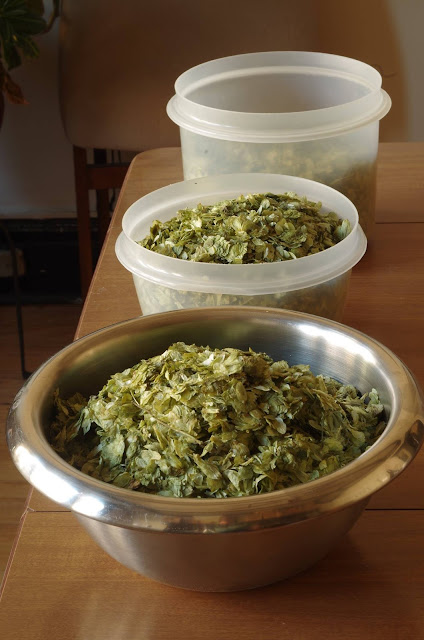I decided to use whole leaf hops this time, both because I presume that was what the Burton brewers used, and because I hoped they might have a freshness that would have been lost in the pelletizing process. This is certainly what the brewers at De Ranke think: in the article I linked to in my last post, Nino says "By using only hop flowers, we ensure the hop oils are never oxidised so we never get any harsh bitterness in our beers". I used pellets in the first version of the beer, which had a distinctive mouthfeel that I associate with large volumes of kettle hops, so I'm hoping I'll only improve things by switching to leaf rather than pellet hops.
Of course, using whole hops in the brewery presents a number of challenges, which are conveniently listed on the De Ranke website:
- When the quality of this expensive material drops, it can lead to off-flavours in the beer, which is why we work closely with a local hop farmer to ensure we always get hops that meet our high standards.
- The annual price fluctuates and depends on the harvest.
- The hops must be refrigerated to maintain quality all year long (which makes them even more expensive)
- Hops can only be bought once a year, just after harvest. It requires good planning for the entire brewing season to avoid hop shortage or surplus.
- Whole-leaf hops require lots of cleaning at the brewery. Hop cones tend to stick to everything during the boiling of the wort, which results in more work for the brewers because the hops must be manually removed, as opposed to breweries that use hop pellets or extracts, which requires far less work to remove.
This fits my experience: whole hops are messy, they take up a lot of space in the freezer, soak up a lot of beer, and make siphoning an absolute nightmare if you don't have some kind of filter or false bottom in place. And as you can see below, these old IPA recipes use a lot of hops...
I brewed a series of beers with these hops (including the De Ranke-inspired beers from the last post, and some others that post about later), and I gradually learnt how to adjust my brew day to accommodate them. The biggest problem is the sheer volume of hop matter in the kettle, especially when (as with these recipes) you're using an exorbitant amount of hops to begin with. I deliberately brewed a whole gallon of extra beer, in anticipation of leaving a lot behind with the hops in the kettle. (Even when I used pellet hops last year, I lost some volume in the IPA batch because I didn't make adjustments.)
The other problem is racking from the kettle. If you have a fancy kettle, with a ball-valve, screen, or even false-bottom, it might not be an issue. I rack with an auto-siphon, which quickly gets clogged by the whole hops, even if I cover the end with some kind of filter. This meant that I had to pour the wort manually from the kettle, which is neither safe nor particularly sanitary (since I inevitably end up making a mess). Frankly, its the kind of dumb s#@t I used to do when I first started brewing, and which I swore off entirely after having surgery to fix an inguinal hernia a few years ago. Still, here I was again, precariously balanced with a heavy kettle as wort splashed off the whole hops over the kitchen floor. No fun at all.
Since I get a lot of trub from my BIAB process, I generally like to whirlpool and leave a good amount of wort in the kettle. Obviously, pouring the whole thing makes this impossible, so instead of doing a whirlpool I poured the wort into a keg as soon as it had cooled, then let this sit for a while until the trub and hop matter had dropped out of suspension. At this point, I racked the much cleaner wort into the final fermentation vessel, oxygenated, and pitched the yeast.
Anyway, back to the beer itself. Besides changing to whole hops, I didn't make any real modifications from the recipe I linked to above: 100% pilsner malt, elevated levels of sulphate (though not quite to the levels reported for historic Burton waters). This time I pitched Wyeast 1318 for the primary fermentation, and the dregs from a beer fermented with Wyeast Brettanomyces Clausenii for the secondary.
Last time the beer was all but undrinkable for the better part of eight months, so I'm not expecting to be drinking it any time soon. I'm hoping the whole hops will soften the bitterness slightly, which might mean I'm drinking this one earlier than the previous version. For now, its sitting in a carboy in my brew closet.




Will you stop posting, er, posts, which make me want to brew them! I really cant keep up.
ReplyDelete:)
This comment has been removed by a blog administrator.
ReplyDelete